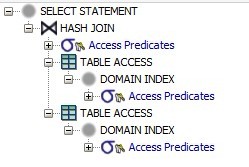Initially I was trying to find out why it's so slow to do a spatial query with multiple SDO_REALTE in a single SELECT statement like this one:
SELECT * FROM geom_table a
WHERE SDO_RELATE(a.geom_column, SDO_GEOMETRY(...), 'mask=inside')='TRUE' AND
SDO_RELATE(a.geom_column, SDO_GEOMETRY(...), 'mask=anyinteract')='TRUE';
Note the two SDO_GEOMETRY may not be necessary the same. So it's a bit different from SDO_GEOMETRY(a.geom_column, the_same_geometry, 'mask=inside+anyinteract')='TRUE'
Then I found this paragraph from oracle documentation for SDO_RELATE:
Although multiple masks can be combined using the logical Boolean operator OR, for example, 'mask=touch+coveredby', better performance may result if the spatial query specifies each mask individually and uses the UNION ALL syntax to combine the results. This is due to internal optimizations that Spatial can apply under certain conditions when masks are specified singly rather than grouped within the same SDO_RELATE operator call. (There are two exceptions, inside+coveredby and contains+covers, where the combination performs better than the UNION ALL alternative.) For example, consider the following query using the logical Boolean operator OR to group multiple masks:
SELECT a.gid FROM polygons a, query_polys B WHERE B.gid = 1 AND SDO_RELATE(A.Geometry, B.Geometry, 'mask=touch+coveredby') = 'TRUE';The preceding query may result in better performance if it is expressed as follows, using UNION ALL to combine results of multiple SDO_RELATE operator calls, each with a single mask:
SELECT a.gid FROM polygons a, query_polys B WHERE B.gid = 1 AND SDO_RELATE(A.Geometry, B.Geometry, 'mask=touch') = 'TRUE' UNION ALL SELECT a.gid FROM polygons a, query_polys B WHERE B.gid = 1 AND SDO_RELATE(A.Geometry, B.Geometry, 'mask=coveredby') = 'TRUE';
It somehow gives the answer for my question, but still it only says: "due to internal optimizations that Spatial can apply under certain conditions". So I have two questions:
What does it mean with "internal optimization", is it something to do with spatial index? (I'm not sure if I'm too demanding on this question, maybe only developers in oracle know about it.)
The oracle documentation doesn't say anything about my original problem, i.e. SDO_RELATE(..., 'mask=inside') AND SDO_RELATE(..., 'maks=anyinteract') in a single SELECT. Why does it also have very bad performance? Does it work similarly to SDO_RELATE(..., 'mask=inside+anyinteract')?
EDIT:
After some research, I've got some additional information. When explaining the execute plan for ANDed SDO_RELATE case, it shows that only one of predicate has been applied with spatial index, the image of the plan is enclosed.

One way to improve the performance I just found is to put one of the SDO_RELATE into sub-query, and that will make both predicate utilize the spatial index. That is:
SELECT * FROM geom_table a
WHERE SDO_RELATE(a.geom_column, SDO_GEOMETRY(...), 'mask=inside')='TRUE'
AND a.id IN (SELECT b.id FROM geom_table b WHERE SDO_RELATE(b.geom_column, SDO_GEOMETRY(...), 'mask=anyinteract')='TRUE');
And the execute plan is:

But I wonder if there is better options, because here the HASH JOIN seems to be an extra cost.
